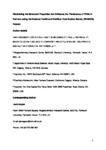Elucidating the structural properties that influence the persistence of PCBs in humans using the National Health and Nutrition Examination Survey (NHANES) dataset.
| dc.contributor.author | Megson, D | |
| dc.contributor.author | O'Sullivan, G | |
| dc.contributor.author | Comber, Sean | |
| dc.contributor.author | Worsfold, Paul | |
| dc.contributor.author | Lohan, MC | |
| dc.contributor.author | Edwards, MR | |
| dc.contributor.author | Shields, WJ | |
| dc.contributor.author | Sandau, CD | |
| dc.contributor.author | Patterson, DG | |
| dc.date.accessioned | 2015-11-10T16:37:56Z | |
| dc.date.accessioned | 2015-11-12T08:33:50Z | |
| dc.date.available | 2015-11-10T16:37:56Z | |
| dc.date.available | 2015-11-12T08:33:50Z | |
| dc.date.issued | 2013-05-25 | |
| dc.identifier.issn | 0048-9697 | |
| dc.identifier.issn | 1879-1026 | |
| dc.identifier.uri | http://hdl.handle.net/10026.1/3807 | |
| dc.description | File replaced (incorrect version) on 16/9/2022 by KT (LDS). | |
| dc.description.abstract |
In human exposure studies involving Polychlorinated Biphenyls (PCBs), it is useful to establish when an individual was potentially exposed. Age dating PCB exposure is complex but assessments can be made because different PCB congeners have different residence times in the human body. The less chlorinated congeners generally tend to have shorter residence times because they are biotransformed and eliminated faster than more chlorinated congeners. Therefore, the presence of high proportions of less chlorinated congeners is often indicative of recent exposure. The 2003-04 National Health and Nutrition Examination Survey (NHANES) dataset contains results for the concentration of 37 PCBs in a sub-sample of the US population. Multivariate statistical analysis of the NHANES data showed that less chlorinated congeners are not always biotransformed faster than higher chlorinated compounds. For example, PCB 28 (a tri-chlorobiphenyl) appears to be more resistant to biotransformation than PCB 101 and 110 (penta-chlorobiphenyls). Using statistical analysis of the NHANES data in conjunction with previously published studies on PCB persistence in humans, it was possible to identify the structural relationships that determine if a PCB is likely to be from a recent exposure (termed 'episodic') or from steady state exposure. Congeners with chlorine atoms in the 2,5- and 2,3,6-positions appear to be more susceptible to biotransformation whereas congeners with chlorine bonds in the 2,3,4- 2,4,5- 3,4,5- and 2,3,4,5-positions appear to be more persistent. This work shows that future investigations to date PCB exposure would benefit from the analysis of a wide range of congeners, including the selection of key congeners based not only on the degree of chlorination but also on the positions of the chlorine atoms on the biphenyl. | |
| dc.format.extent | 99-107 | |
| dc.format.medium | Print-Electronic | |
| dc.language | en | |
| dc.language.iso | en | |
| dc.publisher | Elsevier BV | |
| dc.relation.replaces | http://hdl.handle.net/10026.1/3788 | |
| dc.relation.replaces | 10026.1/3788 | |
| dc.subject | Age dating | |
| dc.subject | Biotransformation | |
| dc.subject | NHANES | |
| dc.subject | PCBs | |
| dc.subject | Polychlorinated biphenyls | |
| dc.subject | Residence time | |
| dc.subject | Adolescent | |
| dc.subject | Adult | |
| dc.subject | Age Factors | |
| dc.subject | Aged | |
| dc.subject | Aged, 80 and over | |
| dc.subject | Biotransformation | |
| dc.subject | Chlorine | |
| dc.subject | Cluster Analysis | |
| dc.subject | Environmental Exposure | |
| dc.subject | Humans | |
| dc.subject | Limit of Detection | |
| dc.subject | Middle Aged | |
| dc.subject | Multivariate Analysis | |
| dc.subject | Nutrition Surveys | |
| dc.subject | Polychlorinated Biphenyls | |
| dc.subject | Principal Component Analysis | |
| dc.subject | Sensitivity and Specificity | |
| dc.title | Elucidating the structural properties that influence the persistence of PCBs in humans using the National Health and Nutrition Examination Survey (NHANES) dataset. | |
| dc.type | journal-article | |
| dc.type | Journal Article | |
| dc.type | Research Support, Non-U.S. Gov't | |
| plymouth.author-url | http://www.ncbi.nlm.nih.gov/pubmed/23712120 | |
| plymouth.volume | 461-462 | |
| plymouth.publication-status | Published | |
| plymouth.journal | Sci Total Environ | |
| dc.identifier.doi | 10.1016/j.scitotenv.2013.04.082 | |
| plymouth.organisational-group | /Plymouth | |
| plymouth.organisational-group | /Plymouth/Faculty of Science and Engineering | |
| plymouth.organisational-group | /Plymouth/Faculty of Science and Engineering/School of Geography, Earth and Environmental Sciences | |
| plymouth.organisational-group | /Plymouth/REF 2021 Researchers by UoA | |
| plymouth.organisational-group | /Plymouth/REF 2021 Researchers by UoA/UoA06 Agriculture, Veterinary and Food Science | |
| plymouth.organisational-group | /Plymouth/Research Groups | |
| plymouth.organisational-group | /Plymouth/Research Groups/BEACh | |
| plymouth.organisational-group | /Plymouth/Research Groups/Marine Institute | |
| plymouth.organisational-group | /Plymouth/Users by role | |
| plymouth.organisational-group | /Plymouth/Users by role/Academics | |
| dc.publisher.place | Netherlands | |
| dcterms.dateAccepted | 2013-04-27 | |
| dc.rights.embargodate | 2014-5-25 | |
| dc.identifier.eissn | 1879-1026 | |
| dc.rights.embargoperiod | Not known | |
| rioxxterms.versionofrecord | 10.1016/j.scitotenv.2013.04.082 | |
| rioxxterms.licenseref.uri | http://www.rioxx.net/licenses/all-rights-reserved | |
| rioxxterms.licenseref.startdate | 2013-05-25 | |
| rioxxterms.type | Journal Article/Review |


